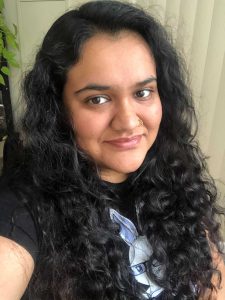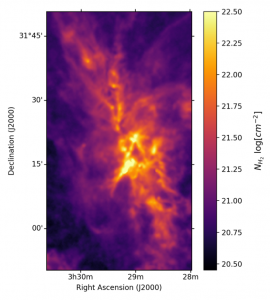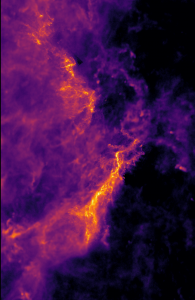University of Toronto Ph.D Student Ayushi Singh has been studying star formation for the past 8 years. She is also our first “Student of the Month.” Meet Ayushi!
Specific research: Star-forming regions
Advisors: Prof. Christopher Matzner and Prof. Peter Martin
Hometown: Toronto, Ontario
Can you tell me a little bit about your specific field of research?
Stars-forming clouds are dense clouds made up of dust and gas. When the gravity over comes the kinetic motion within these regions, the cloud collapses. This lead to star formation. My research is analyzing the stability and structure of these regions in the Milky Way. I use the data taken at various wavelength in infrared and radio by telescopes, such as Herschel Space Observatory, Planck and Robert C. Byrd Green Bank Telescope to estimate the properties of these clouds. For one of my project, I am creating the maps of temperature and column density of these clouds. (See photos and diagrams below). I then use these maps combined with other data to understand the stability. Using a theoretical model, I compute the gravitational and kinetic energies of these clouds to determine if the cloud is bound. My research focuses in fine-tuning the parameters and understanding the uncertainty to better estimate of the stability of the start-forming clouds.
You’re very involved in the U of T astronomy community. What’s your favourite thing about U of T Astro?
One thing I enjoy about the U of T Astro community is different perspectives and openness to discussion. It could be regarding research, outreach or just our favourite sci-fi movie. It is a very supportive and encouraging environment. My advisors are always there to help me. But when I am stuck at something particular, I have been able to reach out to the experts and ask for help.
You’ve been quite involved in extracurriculars like Astrotours and ASX. Why is science communication and outreach important to you?
I think science communications and outreach events are not only important to get more people to be interested in science but to also encourage people to think like a scientist. Science communications is sometimes hard because it can be very intimidating with numbers and statistics. However, the beauty of astronomy is that you can just start by simply looking up at the night sky. It is something that fascinates most of us at some point. What I enjoy most about any event has always been talking to the public. I have had simple conversations about favourite planet turned into a discussion about tidally locked exoplanets and their atmosphere. I think every kid is a scientist when they are young, and ask questions about the world. Science communications is important to keep that curiosity alive even when one grows up.
What do you you hope will be your next step, professionally?
After completing my Ph.D, I will be leaving academia to pursue a career in the industry, either as a data scientist or a developer. I enjoy learning and trying new things. Coding has always been a favourite part of my research. However, I would still want to continue being a science communicator.



